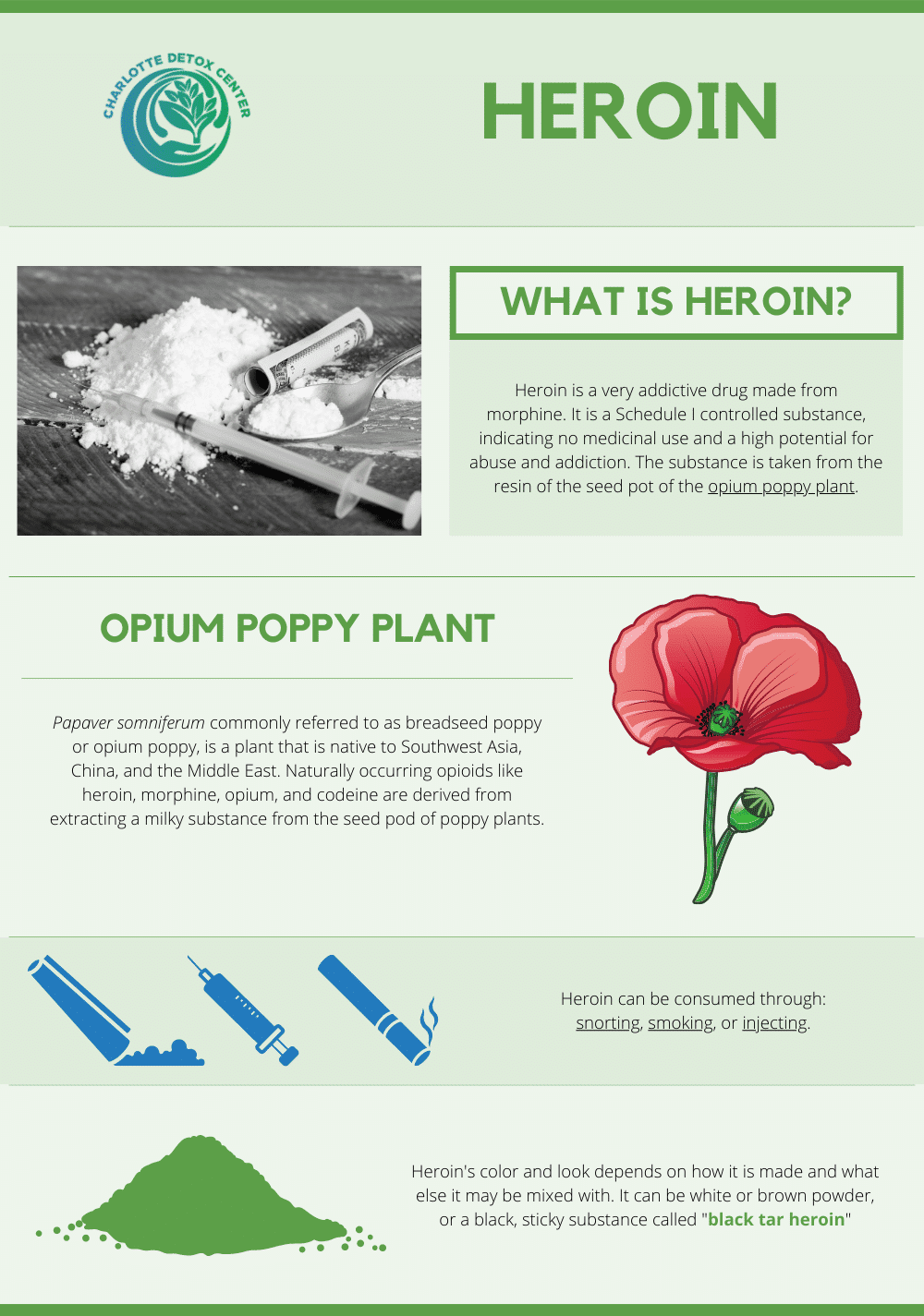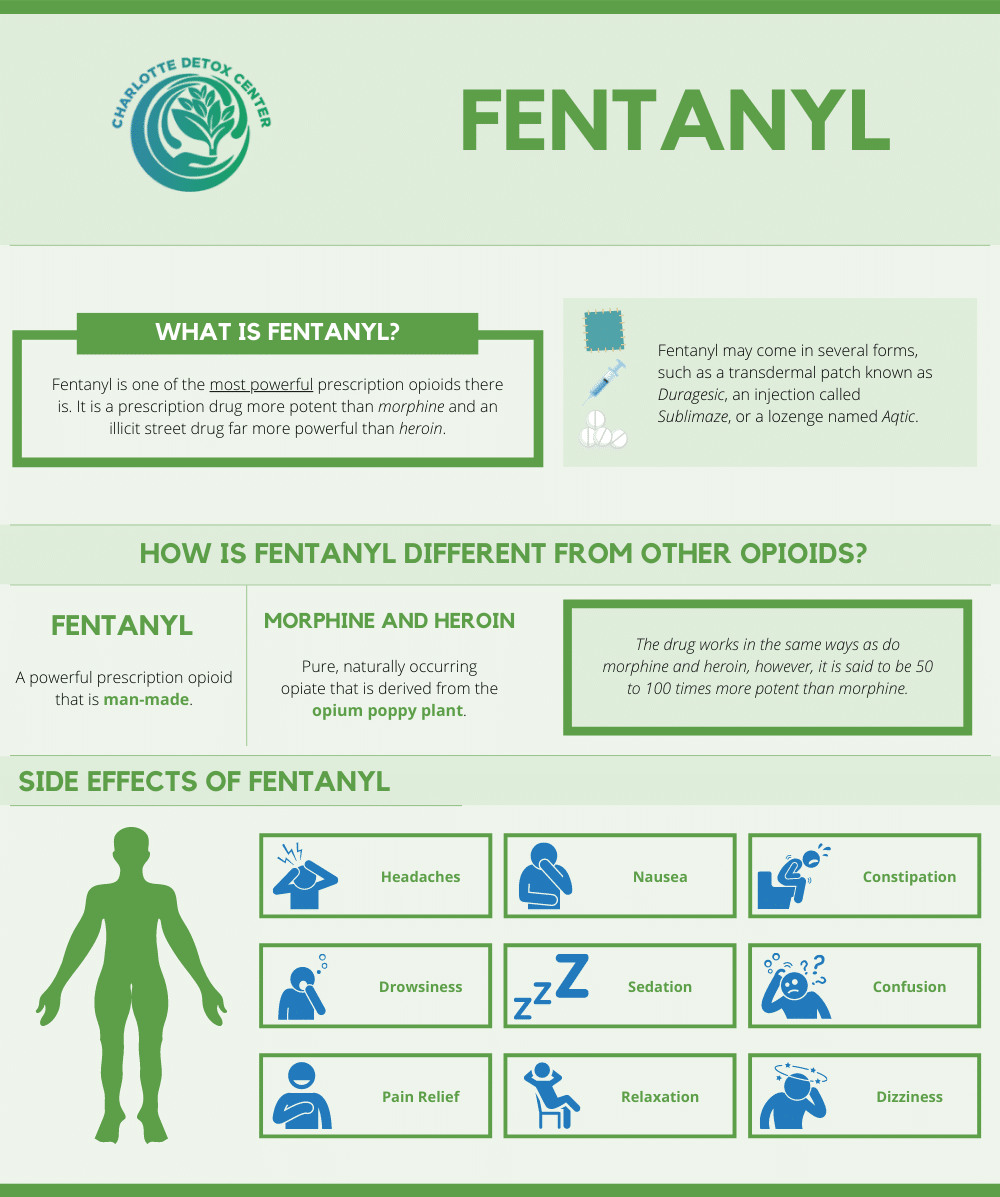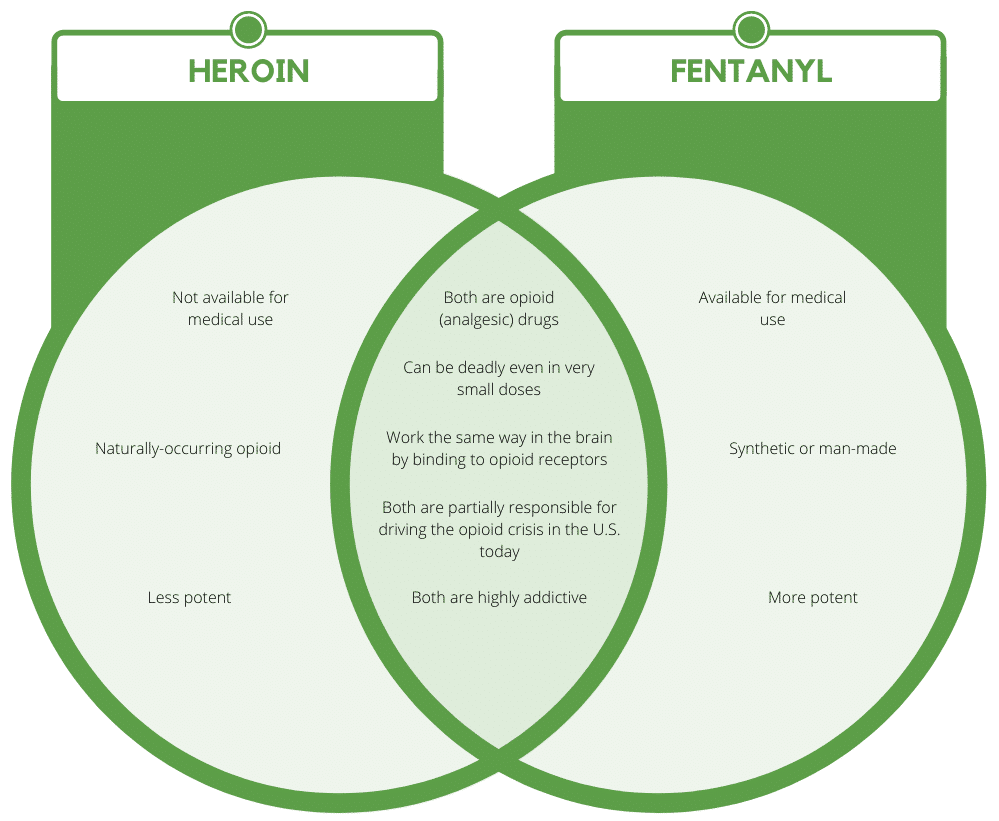Heroin vs. Fentanyl

Medically Verified: 2/1/24
Medical Reviewer
Chief Editor

All of the information on this page has been reviewed and verified by a certified addiction professional.
During the 12-month period ending in April 2021, the United States experienced a 28.5% increase in overdose deaths. Approximately 75,673 people died from an opioid-related overdose during this time. While the last wave of the opioid epidemic was driven by heroin, this new wave seems to be driven by synthetic opioids like fentanyl.[1]
Heroin and fentanyl are two opioid (analgesic) drugs that bind to opioid receptors in the brain. By activating the brain’s opioid receptors, these drugs reduce pain, promote relaxation, and even cause feelings of euphoria. Both of these opioid drugs are extremely potent and can be lethal when abused.
What is Heroin?

Heroin is an illegal opioid drug that is derived from morphine. Morphine is a naturally-occurring opioid that is extracted from the seed pod of the opium poppy plant. This plant is native to Southeast and Southwest Asia, Mexico, and Colombia, but heroin can be found all across America.[2]
Heroin can come in several different forms:
- A white powder that is sometimes called “China white”
- A brown powder
- A black sticky substance that is referred to as “black tar heroin”
The drug is known by many different street names, such as:[3]
- H
- Black tar
- Chiva
- Horse
- Smack
- Dope
- Brown
- China white
- Junk
- Skag
The drug can be smoked, snorted, or injected. Regardless of the method of administration, it enters the brain quickly and reduces pain sensations, decreases heart rate, slows down breathing, and produces feelings of warmth and euphoria.
The U.S. Drug Enforcement Agency (DEA) classifies heroin as a Schedule I controlled substance, meaning it has a high potential for abuse and no accepted medical use.[4]
What is Fentanyl?

Fentanyl is a highly potent and dangerous synthetic (manmade) opioid that is similar to morphine and heroin. However, it is thought to be nearly 50 times stronger than heroin and 100 times more potent than morphine. In recent years, this powerful opioid has been a major contributor to the opioid overdose crisis.
According to the Centers for Disease Control and Prevention (CDC), there are two types of fentanyl:[5]
- Pharmaceutical fentanyl – Fentanyl is available by prescription but it is only used to treat patients with severe pain (specifically after trauma or surgery) as well as patients with chronic pain who are tolerant to other weaker opioids. It is also used to help manage pain in cancer patients.[6] Pharmaceutical fentanyl is typically available in the form of a transdermal patch or lozenge.
- Illicitly manufactured fentanyl (IMF) – Illegal fentanyl or IMF is fentanyl that is sold illegally on the streets for the sole purpose of abusing the drug. It is usually sold in the form of a white powder, however, it may also come in a liquid that is added to blotter paper, nasal sprays, or eye drops.[6] Furthermore, increasing amounts of fentanyl have recently been found in all kinds of drugs in the illegal drug trade, including counterfeit prescription pills, heroin, and marijuana.
Street names for fentanyl include:[7]
- Apache
- Poison
- Butter
- Dragon’s breath
- China girl
- Goodfella
- Fent
- Fenty
On a chemical level, fentanyl works the same way as heroin and morphine. It binds to opioid receptors, reduces pain sensations, and creates a sense of euphoria or pleasure. However, even in the smallest of doses, fentanyl can be deadly.
Is Fentanyl Deadlier Than Heroin?
Both heroin and fentanyl are potent and highly addictive. It is extremely easy to overdose on just one dose of either drug. But, since fentanyl is far more potent, it is easier to overdose on fentanyl than it is on heroin.
Another reason why fentanyl is so deadly is that many street drugs today contain unknown levels of fentanyl. People often believe they are purchasing heroin, a prescription opioid, or Xanax, but the truth is they are buying an illegally manufactured substance that has been cut with fentanyl to decrease the costs and increase the potency. And, unless a person uses a fentanyl test strip to test their substances, there is no way to know when a drug contains fentanyl.[5]
Signs of opioid overdose include:

- Constricted or “pinpoint” pupils
- Loss of consciousness
- Slow, weak, or no breathing
- Choking or gurgling sounds
- Cold or clammy skin
- Blue-colored lips, nails, or skin
- Limp body
While opioid overdose can be reversed using Narcan (naloxone), the reversal medication only works if it is administered in due time. The CDC reports that nearly 150 people die each and every day from an overdose on synthetic opioids like fentanyl.
Similarities and Differences Between Heroin and Fentanyl

Overall, heroin and fentanyl are more similar than they are different. Key similarities are:
- Both are opioid (analgesic) drugs
- Can be deadly even in very small doses
- Work the same way in the brain by binding to opioid receptors
- Both are partially responsible for driving the opioid crisis in the U.S. today
- Are highly addictive
Still, there are stark differences between the two drugs, such as:
- Fentanyl is available for medical use while heroin is not
- Heroin is considered a naturally-occurring opioid while fentanyl is synthetic or man-made
- Fentanyl is far more potent than heroin and may be easier to overdose on
Find Help for Opioid Addiction Today
Both heroin and fentanyl can not only cause overdose, but they can also lead to long-term damage to the entire body. People who struggle with long-term opioid use often develop problems with the respiratory, cardiovascular, and central nervous systems. Unfortunately, due to the addictive nature of both drugs, it can be difficult to get sober without professional help.
Here at Charlotte Detox Center, we help opioid users with the hardest part: detox. Our medication-assisted detox program can prescribe medications that reduce the symptoms of withdrawal, alleviate drug cravings, and help individuals get started on their recovery journey. Once patients are physically and mentally stable, they can meet with a substance abuse counselor to devise a plan of action for further treatment.
If you or a loved one are addicted to opioids, there is no reason to delay treatment. Fentanyl is being found in all sects of the illegal drug supply and is becoming harder and harder to avoid. You don’t have to succumb to a life fueled by opioids. There is help available. Call now to get started.
References:
- https://www.cdc.gov/nchs/pressroom/nchs_press_releases/2021/20211117.htm
- https://www.drugabuse.gov/publications/drugfacts/heroin
- https://www.dea.gov/factsheets/heroin
- https://www.dea.gov/sites/default/files/2020-06/Heroin-2020.pdf
- https://www.cdc.gov/stopoverdose/fentanyl/index.html
- https://www.drugabuse.gov/publications/drugfacts/fentanyl
- https://www.dea.gov/sites/default/files/2018-07/DIR-020-17%20Drug%20Slang%20Code%20Words.pdf
